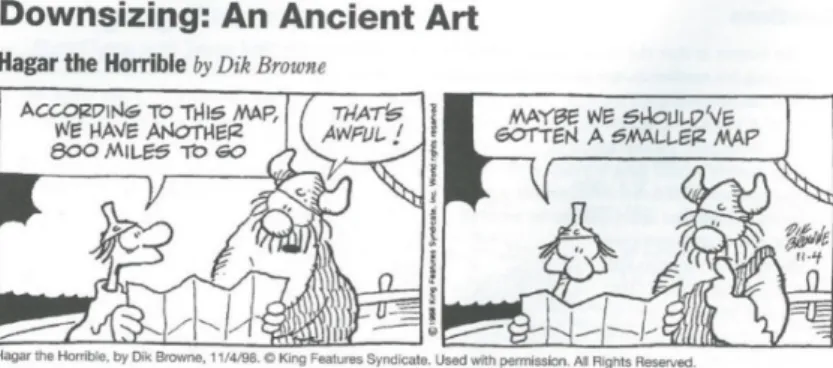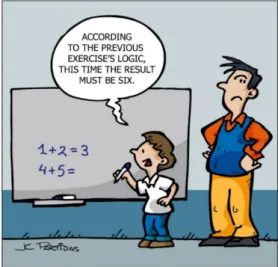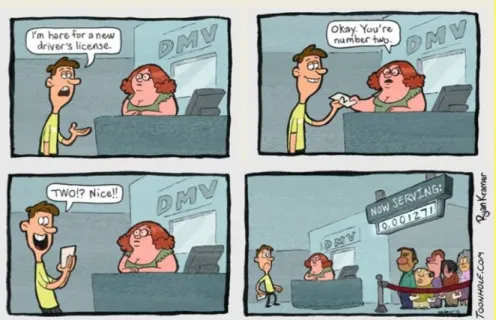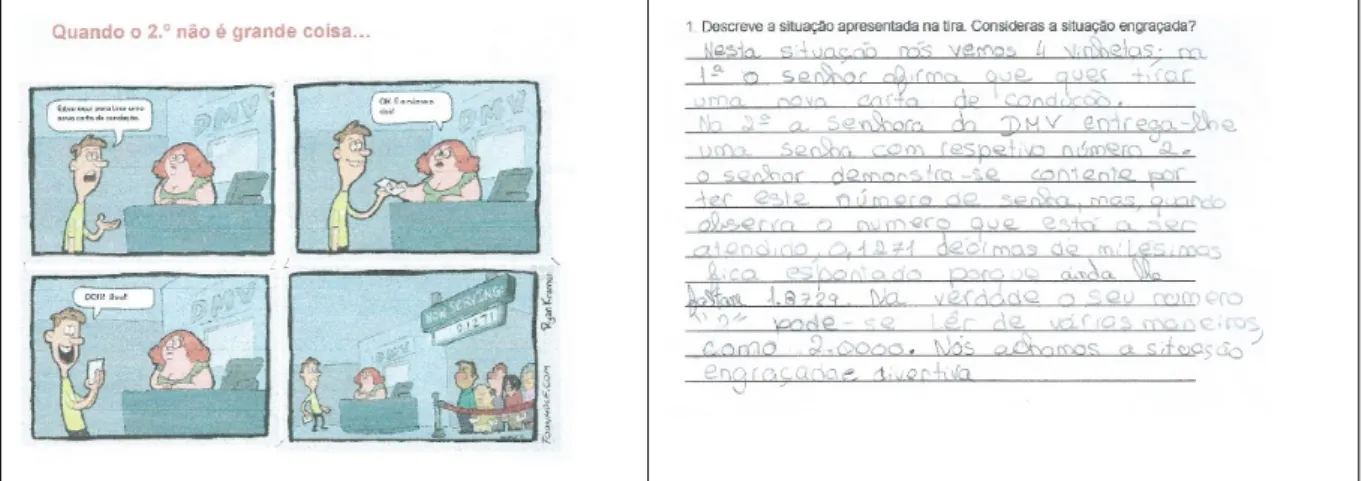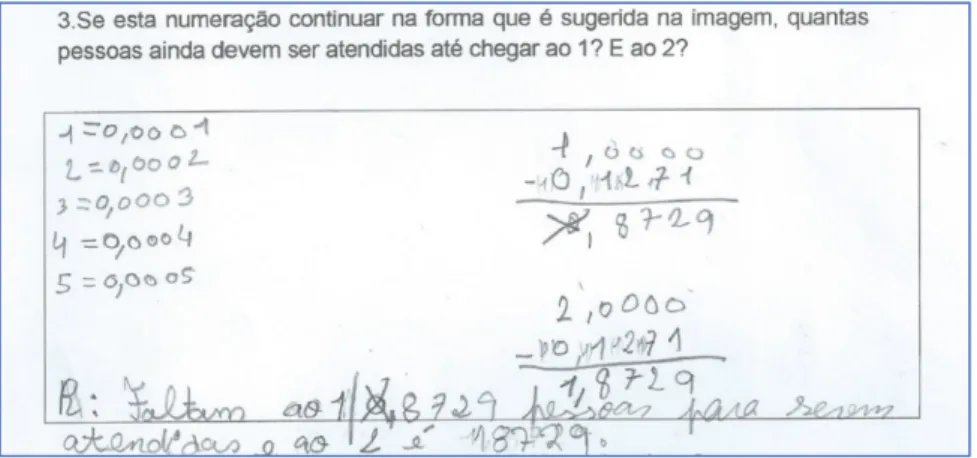HUMOUR IN MATHEMATICS TEACHING CAN BE A SERIOUS
THING!
Luís Menezes
Instituto Politécnico de Viseu (PORTUGAL)
Abstract
This study focuses on the educational possibilities of instructional humour in the teaching of Mathematics in the final stages of primary education. It is an exploratory study whose main objective is to understand the role that mathematical tasks, based on humorous situations (cartoons or comic strips), might play in the learning of Mathematics and in the development of mathematical communication and mathematical knowledge. In order to reach this goal, three mathematical tasks, based on humorous cartoons involving mathematical concepts, were applied in a fourth-year class. Students worked in pairs in order to solve those given tasks. The work done by the students was then discussed collectively. The research adopted a qualitative methodology. The data collected come from class observation, audio recordings and from students’ written conclusions. The results reveal that those humour-based mathematical tasks have succeeded in catching students' attention to the learning of Mathematics. The students were able to understand the humorous situations depicted in the cartoons using their mathematical knowledge and were capable of developing that knowledge while solving the problems. The students wrote well developed texts based on the images presented, mobilizing their mathematical knowledge to understand the humour. The answers reveal students’ ability to combine their native language and mathematical language.
Keywords: Teaching, Instructional humour, Mathematical tasks, Writing in Mathematics Classroom.
1 INTRODUCTION
This is an ongoing study that takes place as part of the HUMAT research project: "Humor in Mathematics Teaching" (Menezes et al., 2016). In this project, we assume, as many other authors and Organizations do (Banas, Dunbar, Rodriguez & Liu, 2011; Flores & Moreno, 2011; Martin, 2007; NCTM, 2007, 2013) that humour can have a relevant place in school, and, in particular, in the teaching of Mathematics. Humour can help reduce the kind of stress that this school subject may cause in many students and create a pleasant and challenging environment that will help students think mathematically and learn Mathematics (Flores & Moreno, 2011; Guitart & Flores, 2003; Guitart, 2012). In the classroom, humour can be both spoken (and has to do with the teacher's speech) or written (and will then take the form of mathematical tasks based on humorous/funny cartoons or comic strips) (Banas et al., 2011; Flores & Moreno, 2011, Menezes, Viseu, Ribeiro & Flores, 2017). When the use of humour is essentially spoken, it tends to be used in sporadic situations and depends on the teacher’s sense of humour, and is usually introduced to create and promote a good learning environment (Banas et al., 2011). What will happen when the use of humour is essentially written and based on previously planned mathematical tasks which include graphic humour?
This study intends to understand the role that mathematical tasks, based on humorous situations (cartoons), will play in the learning of Mathematics, in the development of students’ mathematical communication, particularly their writing communication, and of their mathematical knowledge.
2 THEORETICAL FRAMEWORK
2.1 Humour, education and Mathematics
Humour and laughter are universal aspects of human activity occurring in all cultures and which are caused, for the most part, by enjoyable and amusing situations (Martin, 2007; Meyer, 2015). Humour may be defined as the “quality of being amusing or comic; the ability to make other people laugh” (Lovorn & Holaway, 2015, p. 25). Banas et al. (2011) consider, following Martin (2007), that humour “involves the communication of multiple, incongruous meanings that are amusing in some manner” (p. 117). These authors maintain that humour is a form of communication, both verbal and non-verbal whose intention is to make people laugh. From a psychological perspective, Martin (2007) points out
that the humorous act is divided into four components; “(1) a social context; (2) a cognitive-perceptual process; (3) an emotional response, and (4) the vocal-behavioural expression of laughter” (p. 5). Humour, like communication, is a form of social influence that can fulfil multiple functions, such as increasing group cohesion and helping people cope with stress (Banas et al., 2011; Martin, 2007). Therefore, it has been used in many areas of human activity, from recreational activities to work practices. Humour has been used in Education with instructional purposes (Banas et al., 2011; Flores & Moreno, 2011; Guitart & Flores, 2003; Martin, 2007). Drawing upon 40 years of research on humour in Education, Banas et al. (2011) point out that the use of humour “has been associated with a more interesting and relaxed learning environment, higher effective instructor evaluations, greater perceived motivation to learn and enjoyment of the course” (p. 137).
Humour in teaching involves “comic words, actions or reactions of a teacher in the act of teaching, engaging and interacting with students, managing a classroom, and/or setting a tone for timely and appropriate mirthful response to content or activities” (Lovorn & Holaway, 2015, p. 25). Most of this use of instructional humour is associated with the teachers’ oral discourse, with the verbal interactions they will use to create a good and pleasant atmosphere in the classroom and to help students memorize the information (Banas et al., 2011). In recent years, in the field of Mathematics teaching, proposals have been made so that graphic humour based on comic strips or cartoons could be used in class (Flores & Moreno, 2011; Guitart & Flores, 2003; NCTM, 2007, 2013). This kind of humour combines the emotional function (creating good classroom environment) with the cognitive function of humour (challenging students to think and solve problems based on mathematical humour) (Flores & Moreno, 2011).
Based on this perspective of instructional humour, some authors have developed mathematical tasks which start with a situation that takes advantage of or relies on graphic humour, like those depicted in Figure 1 (NCTM, 2013) and figure 2 (Menezes et al., 2017):
Figure 1. “Hagar The Horrible” comic strip from which the task “Downsizing: An ancient art” was developed (NCTM, 2013, p. 84).
These tasks, as well as all those applied in this study, are part of the book "Humor in Mathematics Teaching: Tasks for the classroom” (Menezes et al., 2017).
2.2 Writing in Mathematics Classroom
When Mathematics classes do not follow a traditional model of knowledge transmission, students are required to engage in intense mathematical activity, to interact with others and to discuss their findings in order to develop their mathematical competence (Canavarro, 2011; Menezes, Oliveira & Canavarro, 2015). These students’ mathematical activity derives from mathematical tasks that challenge them to think mathematically and to write more freely. Contrary to what happens in traditional teaching (in the so-called exploratory teaching of Mathematics), students are asked to write more extensively and to be more creative, mobilizing and deepening their mathematical knowledge (Burton & Morgan, 2000; Guerreiro, Tomás Ferreira, Menezes & Martinho, 2015; Morgan, 2002).
What is the nature of mathematical writing? A combination of mathematical symbolism with the students’ native language (and which includes the specialized vocabulary of Mathematics), and can also incorporate other representations, such as diagrams, tables, drawings (Morgan, 2002; Pimm, 2002). Morgan (2002) explains that “in addition to specialist vocabulary and structures, other features that are characteristic of the mathematical text include its ‘density and conciseness” (p. 10). In a traditional Mathematics class, students' writing is mainly based on the use of mathematical symbolism and are, essentially, important to present a final product. In an exploratory Mathematics class, the texts reveal, in addition to the product, the process that led to it resorting to a more balanced use of mathematic language and the participants’ native language.
What are the benefits of math writing? Morgan (2002) highlights the fundamental benefits of promoting written in Mathematics classes: (1) Writing produces a lasting record; (2) Writing and Mathematics are similar activities; (3) Writing develops mathematical understanding; (4) It favours positive attitudes towards Mathematics; and (5) eases the assessment of the Mathematical learning process. Mathematical writing can be stimulated through different strategies, systematized by Morgan: (1) "Describe what you have done"; (2) "Explain why something works"; (3) "Create a wall journal/newspaper"; (4) "Write stories about Mathematics"; (5) "Describe images": and (6) "Solve problems" (Burton & Morgan, 2000; Menezes, 2011; Morgan, 2002). In this study, we use tasks based on graphic humour (images) to encourage students to think and write about Mathematics and communicate/share orally the results they obtained as they solved their mathematical tasks.
3 METHOD
3.1 Options and procedures
In terms of methodological options, the study adopts an interpretative and qualitative approach. The study participants are 24 fourth graders from a Portuguese class (final year of Portuguese primary education) and their teacher (who has been teaching for more than 30 years). Data were collected through the observation of 3 classes (each one of those classes was approximately 90 minutes long), audio recordings of those classes and the students’ writings (task solving).
The tasks were presented to the teacher as part of a short in-service training on Didactics of Mathematics. The teacher was free to choose how she would like to implement the tasks suggested and was allowed to make the changes she deemed necessary in the text of the cartoons/comic strips. Taking into account the characteristics and needs of her students, a few changes were made in the former and in the latter as well.
Data analysis focused on the following aspects: (i) the students’ understanding of humour; (ii) the use of some mathematical concepts and their capacity to use specific vocabulary and notation; (iii) the organization, originality and clarity of their text; (iv) the completion of the given task. Concerning the first aspect, I have to verify if students had understood the humorous situation. Regarding the second aspect, I have to verify if students are using mathematical concepts correctly and the correction of their vocabulary. As for the third aspect, I have to verify the organization of the students’ ideas, their originality and clarity. Regarding the fourth aspect, I have to check out if the task has been correctly solved.
3.2 Mathematical tasks
The following mathematical tasks based on graphic humour were developed for the book "Humor in Mathematics teaching: tasks for the Classroom" (Menezes et al., 2017). The tasks were presented by the teacher, in her classes, the way they are presented here. The task "When number 2 is not that big a deal" is an exception because the teacher made two changes to the original proposal. She changed the number displayed in the fourth panel from 0.001271 to 0.1271 (because her students were more familiar with that number and because she understood that that change would not compromise the humour of the situation). She also changed the way the strip would be presented to the students: rather than projecting the entire comic strip at the same time, she chose to show one panel at a time.
3.2.1 Irregular regularity
Figure 3. Illustration of the task “Irregular regularity”.
1 Describe the situation depicted in the cartoon. Do you think this is an amusing situation? 2 Why has the student replied “six”?
3 Find regularities in additions of natural numbers and justify them.
Note: This mathematical task starts with a comic strip created by Juan Carlos matches, a Venezuelan designer and the author of a blog called Rechiste.
1 Describe the situation pictured in the cartoon. Do you think it’s funny? 2 Could there be any “truth” in the situation pictured? Why?
3 How could you correct the result of the operation without deleting any of the numbers? Note: This mathematical task uses an illustration created by Randy Glasbergen, one of America’s most popular cartoonists.
3.2.3 When number 2 is not that big a deal…
Figure 5. Illustration of the task “When number 2 is not that big a deal…!”.
1 Describe the situation presented in the comic strip. Do you think the situation is amusing? 2 Assuming that, that day, 0 was the first number taken, how many people may have already
been assisted?
3 If this numbering were to continue as suggested in the panel, how many people are to be assisted until they reach number 1? And number 2?
Note: This mathematical task uses a comic strip from a blog called “Toon Hole”, created by the American graphic illustrator, Ryan Kramer.
4 RESULTS
In this section, I present the results related to the students’ mathematical writing in the different tasks presented by the teacher. All those tasks followed the same sequence: (1) Projection of the cartoon to introduce the task to the students, which was followed by a brief sharing of opinions with the class regarding the situation depicted; (2) Students try to solve the task in pairs; and (3) Collective discussion of the student resolutions.
In the "Right or Wrong" task, there are a number of aspects that stand out from the students ' resolutions. Figure 6 shows that the students wrote a long text, which shows that they had understood the humour of the situation (considering that the student from the cartoon was making fun of her teacher). They have predominantly used their native language (which is perfectly expectable given the initial question), their answers were quite original (as they use drawings, direct speech) and their answers were in agreement with the purpose for which the task was designed:
Students wrote:
We thought the student was making fun of her teacher because the mathematical operation was 2x3. Because she wanted to make fun of the teacher, the girl wrote 222, but the result should have been 6 because 2 + 2 + 2 = 6. The teacher asked herself, "Is it right or wrong?
In fact, 2 + 2 + 2 = 6 and 2x3=6
Figure 6. G3's answer to the first question (“Right or Wrong"). Figure 7 shows the resolution presented by another group
Students wrote:
In a math class, Miss Hermelinda, the teacher, asked Julieta to perform a mathematical operation (2x3). Julieta got up, headed for the board and did what she had been asked. Since she was having some trouble understanding that part of the class, she wrote 222. The teacher told her she was wrong and Julieta replied:
“But Miss, it makes perfect sense to write three “2” since the operation was 2x3.
The teacher looked at her in awe because that possibility didn’t cross her mind. Then, she replied: “You’re right, this is wrong but it might also be right. The teacher gave her an A+ and Julieta became her teacher’s doctor a few years later.
Figure 7. G7's answer to the first question (“Right or Wrong").
This group of students wrote quite a long text in which they describe the situation and show that they had enjoyed the humour. These students wrote a story based on the picture and created characters, which reveals how creative they are. In their text, they mainly resort to their native language to talk about mathematical concepts related to multiplication: students show that they understand that multiplication involves the repeated addition of equal numbers and use this knowledge to have fun and solve the task.
In the "Irregular Regularity" task, students recognize the humour that involves the situation (Figure 8), pitting the teacher’s logic against the student’s reasoning: the students found a way for the student to be right "it would have made more sense if he didn’t write =". Students also tried to write a text in which they would use mathematical language as well as their native language to solve the task. It is surprising to realise that the students tried to symbolize (symbolising) when they decide to put a circle around 6 to show that the result was wrong.
Students wrote:
Yes, the teacher and the student had both a correct mathematical reasoning but their way of thinking was quite different. The teacher thought that the right way was (1+2=3 and 4+5=9) and the student thought that (1+2=3 and 4 and 5 =6). It would have made more sense if he didn’t write “=” because 123456.
In the task "When number 2 is not that big a deal", students reacted very positively to the way the comic strip was presented, panel after panel, and showed their amazement using different kinds of expressions: "Aaaaaaaah!!," Eeeeeeee! "," Xiiiiiiiii ". Most students laughed and commented on the situation:
Camila: Wow, the person who has ticket number 1 has not yet been assisted!
Guilherme: Maybe it's moving backwards and it's going to take a long time to get to number2.
Teacher: To allow each group to look for its own explanation, we will now work in pair and we will not,
for now, share all the conclusions. We'll do that later on.
In response to the questions, students produced detailed texts describing the situation (Figure 9).
Figure9, Explanation for question 1 (“When number 2 is not that big a deal…”). Students wrote:
In this situation, we see a young man who wants to get his new driving license. The DMV lady gives him the number 2. The young man is glad to have this number, but when he looks at the number of the person who is being assisted (0, 1271) he is surprised because there are still 18729 persons who will have to be assisted before him. In fact, number "2" can be read in several ways, like "2,0000", for instance. We found the situation funny and very entertaining.
The answer shows that students have understood the situation, since they use their mathematical knowledge of rational numbers in a situation where this use was not evident, and established a correspondence between the natural numbers and the numbers shown in the Figure. In this answer, mathematical language prevails (Figure 10):
To answer question 3 ,“If this numbering were to continue as suggested in the panel, how many people are to be assisted until they reach number 1? And number 2?”, all students used the subtraction algorithm for decimal numbers (Figure 11).
Figure 11. Answer to the third question (“When number 2 is not that big a deal…”).
To answer question 4, added by the teacher, students wrote: “When the number 2 is not that big a deal” means that sometimes the 2nd is not very good because we can be dealing with a situation that involves tenths of a thousandth and number 2 would still be a very distant number” (Figure 12).
Figure 12. G1's answer to the fourth question (“When number 2 is not that big a deal…”).
Another pair of students wrote: “This title means that number 2 or the 2nd is not always a good number because you can read that number in many ways (as if it were 2,000, for instance) ... we may have to wait a long time if the numbers are represented by decimal numbers.” (Figure 13).
Figure 13, G5's answer to the fourth question (“When number 2 is not that big a deal…”).
In this task, the texts that students produced to answer questions 1 and 4 reveal that they mostly use their native language, and when they answer questions 2 and 3, it’s the mathematical language that prevails. The answers also reveal that students have understood the humour of the situation and were able to use their mathematical knowledge to solve the problem caused by that strange way of counting.
5 CONCLUSIONS
This study focuses on the educational possibilities that instructional humour can offer to the teaching of Mathematics in the final of primary education. Its main aim is to understand the impact that mathematical tasks, based on humorous cartoons, can have on the learning of Mathematics, on the development of mathematical writing communication and mathematical knowledge.
Although it is an exploratory study, the results suggest that the tasks based on graphic humour; (a) are well received by students, who strive to solve those tasks and have fun while doing so (emotional function); (b) involve students in mathematical activity, mobilizing their mathematical knowledge (cognitive function); (c) develop students' written communication which tends to become more and more creative (as we can verify from the structure of their texts and from the accuracy of the mathematical content), involving mathematical language and students’ native language (this language gains increasing importance as their explanatory texts are more and more structured and complete). These results reinforce those presented by other authors, although they predominantly relate to other levels of teaching (Flores & Moreno, 011; Guitart, 2012); Menezes, Ribeiro, Flores & Viseu, 2017), suggesting that graphic humour in Mathematics teaching can be a serious thing!
ACKNOWLEDGEMENTS
This work is financed by national funds through FCT - Fundação para a Ciência e Tecnologia, I.P., under the project UID/Multi/04016/2016. Furthermore, we would like to thank the Instituto Politécnico de Viseu and CI&DETS for their support.
REFERENCES
[1] A. Guerreiro, R. Tomás Ferreira, L. Menezes, and M. H. Martinho, “Comunicação na sala de aula: A perspetiva do ensino exploratório da Matemática”, Zetetiké, vol. 23, no. 4, pp. 279-295, 2015.
[2] A. P. Canavarro, “Ensino exploratório da Matemática: Práticas e desafios” Educação e
Matemática, 115, pp. 11-pp. 17, 2011.
[3] C. Morgan, “Writing Mathematically: The Discourse of Investigation”. London: Routledge, 2002. [4] D. Pimm, “Symbols and meanings in school mathematics”. London: Routledge, 2002.
[5] J. A. Banas, N. Dunbar, D. Rodriguez, and S. J. Liu, “A review of humor in educational settings Four decades of research”, Communication Education, vol. 60, no. 1, pp. 115-144, 2011. [6] J. C. Meyer, “Understanding Humor Through Communication: Why be Funny, Anyway?”.
Lanham: Lexington Books, 2015.
[7] L. Burton, and C. Morgan, “Mathematicians Writing“. Journal for Research in Mathematics
Education. Vol. 41, no.4, pp. 429-pp. 453, 2000.
[8] L. Menezes, F. Viseu, A. Ribeiro, and P. Flores, "O humor nas práticas letivas dos professores que ensinam Matemática" in Seminário de Investigação em Educação Matemática (L.
Menezes, A. Ribeiro, H. Gomes, A. P. Martins, F. Tavares, H. Pinto eds.), pp.51-pp.67, Viseu: APM, 2017.
[9] L. Menezes, H. Gomes, A. Ribeiro, A. P. Martins, P. Flores, F. Viseu, A. M. Oliveira, I. A. Matos, J. P. Balula, and V. Delplancq, “Humor no ensino da Matemática: Tarefas para a sala de aula”. Viseu: ESE -IPV, 2017.
[10] L. Menezes, H. Oliveira, and A. P. Canavarro, "Inquiry-based mathematics teaching: The case of Célia" in Educational paths to Mathematics (U. Gellert, J. Gimenez Rodriguez, C. Hahn, S. Kafoussi, eds.), pp.305-pp.321, Cham: Springer, 2015.
[11] M. Guitart, and P. Flores, “O Humor gráfico para la enseñanza y el aprendizaje del azar”,
Suma, no. 42, pp. 81-89, 2003.
[12] M. Guitart, “Permitido reír... Estamos en clase El humor como recurso didáctico en aula de
[13] M. Lovorn, and C. Holaway, “Teachers’ perceptions of humour as a classroom teaching, interaction, and management tool”. The European Journal of Humour Research, vol. 3, no. 4, pp. 24-pp.35, 2015.
[14] NCTM (National Council of Teachers of Mathematics), “Cartoon Corner: Humor-Based
Mathematics Activities” (Edited by A. Reeves). Reston, VA: National Council of Teachers of
Mathematics, 2007.
[15] NCTM (National Council of Teachers of Mathematics), “Cartoon Corner 2: Humor-Based
Mathematics Activities” (Edited by P. House). Reston, VA: National Council of Teachers of
Mathematics, 2013.
[16] P. Flores, and A.J. C Moreno, “Matemáticamente competentes para reí”r. Barcelona: Graó, 2011.
[17] R. Martin, The Psychology of Humor – An Integrative Approach. London: Elsevier Academic Press, 2007.
